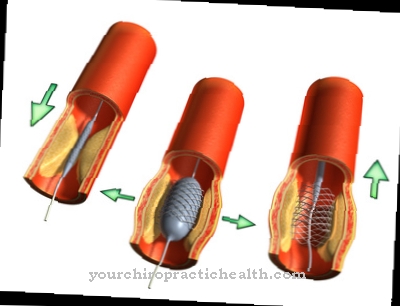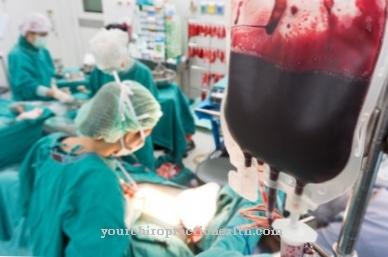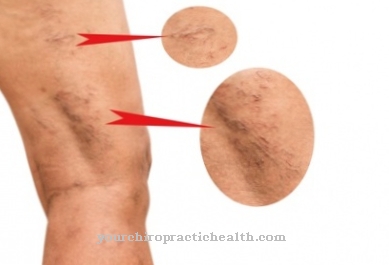In the Quadrantectomy is a surgical procedure to remove breast cancer while preserving the breast. This method is one of several breast-conserving therapies (BET). The implementation of this procedure is linked to a number of requirements.
What is the quadrantectomy?

In the 1970s, the Italian surgeon Umberto Veronesi developed quadrantectomy, a new surgical procedure for breast-conserving therapy. He removed the area of the breast that contained the tumor. Since with this method only the affected quarter of the breast is excised, he called the procedure a quadrantectomy. The term quadrant stands for quarter. In comparison, a mastectomy involves removing the entire breast.
This is why the quadrantectomy is also referred to by some medical professionals as a partial mastectomy or segmental mastectomy. However, in addition to quadrantectomy, breast-conserving therapies also include lumpectomy and segment resection. In both of these procedures, only the tumor and up to 2 cm of healthy tissue, and especially the nipple in the segment resection, are removed. Today, quadrantectomy, along with the other two breast-conserving therapies, is a standard method in breast cancer treatment.
Function, effect & goals
Quadrantectomy as a breast-conserving therapy was introduced alongside the other two BET procedures after it became clear that a malignant tumor does not always require removal of the entire breast. However, with mastectomy, women often suffer psychologically from the removal of the entire breast.
Today, breast-conserving operations are therefore the standard method when the removal of the entire breast is not necessary. Which method is used for BET is on the one hand left to the individual surgeon and on the other hand also depends on the size and extent of the tumor to be removed. For example, BET including quadrantectomy is indicated in the presence of breast cancer or DCIS (ductal carcinoma in situ). Many studies have shown that BET in malignant breast cancer has, in most cases, the same effect on overall survival as a mastectomy.
In DCIS, the cancer is limited and only affects the milk duct system. A BET with a resection margin of ten millimeters in healthy tissue already leads to reliable control of the tumor. However, there are certain prerequisites for BET including a quadrantectomy. There must be a small, demarcated tumor no larger than four centimeters. The tumor must not involve skin. There must still be a sufficient breast-to-tumor ratio. The axillary lymph nodes must not yet be affected according to the palpable findings. There must be a tumor-free resection margin of at least one millimeter in the presence of a breast cancer.
Absolute contraindications are according to the guidelines of the "Deutsche Krebsgesellschaft e.V." multicenter carcinomas, carcinomas with inflammatory processes, a poor tumor-to-breast ratio and the impracticability of radiation. After extensive preoperative diagnostics, the decision is made as to whether a BET method can be used and if so which one. In a quadrantectomy, the affected quadrant is removed with the appropriate skin spindle. If the laterocranial quadrant (top side) is affected, it may also be necessary to remove the associated axillary lymph nodes or the sentinel lymph nodes.
If these are not yet affected, the other lymph nodes do not need to be removed either. Because the sentinel lymph nodes are always the first to be reached by the tumor cells. Quadrantectomy is often combined with other therapeutic methods such as removal of axillary lymph nodes and radiotherapy. This combination is also known as QUART. After the tumor has been removed, the tissue section is examined to ensure complete removal of the tumor. If not all of the tumor tissue has been removed, a follow-up operation must be carried out.
The quadrantectomy is followed by subsequent therapy with radiation, chemotherapy or antibody therapy. During follow-up care, a mammogram should be performed every six months for the next three years. This also includes testing for adverse drug effects.
You can find your medication here
➔ Medicines to strengthen the defense and immune systemRisks, side effects & dangers
Quadrantectomy, like all other surgical procedures, carries risks and complications. It happens that not all tumor cells have been removed. Then there may be a relapse within the next five years. If necessary, tumor cells have already spread over the lymph glands and are already forming metastases. Furthermore, inflammatory reactions due to infections are also possible after the operation.
This applies to both the wound cavities and the scars. As with any operation, thrombosis in the lower extremities can occur in rare cases with the risk of pulmonary embolism. Secondary bleeding can also occur, which occasionally requires surgical hemostasis. In contrast to segment resection, the nipples are usually retained with quadrantectomy. The central quadrantectomy is an exception. Nevertheless, deformations or asymmetries can occur after the procedure. The challenge in these cases is to correct the cosmetic deficits.
It is possible to use an autologous transplant. The body's own tissue is used immediately after the operation to compensate for the asymmetries. A skin-muscle transplant of the large back muscle (Musculus latissimus dorsi) has proven itself. In contrast to a mastectomy, the quadrantectomy retains the breast, even if corrections are sometimes necessary. A long-term study over 20 years has also shown that quadrantectomy with subsequent radiation therapy and mastectomy with complete breast removal have the same long-term survival rates.
























.jpg)



